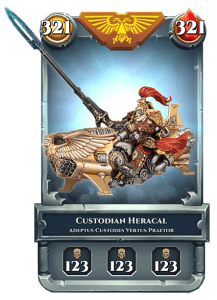Hi, and welcome to the second part of how new cards are added to Combat Cards. Although interrupted by last week’s post on the Rank changes, the first part of this post talked about why we add new cards, so this time let’s go through HOW it’s done.
Gaps

Work in progress (note the non-final stats) example of an upcoming Servants of the Emperor card.
First, once we’ve decided on a gap in a particular faction we look for potential miniatures to fill it. For example, the Servants of the Emperor faction is tending towards slow, ranged attack cards, so we’ll add a fast, melee focused card. An obvious fit is a Custodes Venator.
Next we source the miniature artwork, looking through Warhammer 40,000 publications to find a suitable image of it. This tends to mean we need images where the character is facing the camera (for ‘tall’ miniatures) or around 45 degrees off that (for ‘wide’ miniatures).
Once we’ve been sent the high-res image of the miniature by Games Workshop, the work splits into two streams – design and art.
Art
As you’d expect, we don’t simply take the picture of the miniature and slap it into a card border – there are a lot of steps our artists go through:
- We colour and light balance each miniature to ensure they work on mobile screens, without being too garish or becoming lost against the background.
- We decide which ‘sticking out bits’ (very much not a technical term our artists use, but I’m hoping it’ll catch on) will protrude from the card’s borders. This is a balance between dynamism and losing the miniature’s silhouette in the card border.
Design
Meanwhile, design is providing the following:
- The card’s name and subtitle, which we talked about way back in post 9.
- The card’s stats. These aren’t trying to be an exact match for the numbers in a codex, but are instead based on how that miniature fights in tabletop Warhammer 40,000, This includes which attacks it uses, how difficult it is to kill, how quick it is, and so on.
- Their trait, again based on choosing the most appropriate one to reflect how they fight.
- If they’re a Warlord, their special rule (more on these in a later post).
- The card’s points cost (again, more on how we work this out in a later post).
When everything’s ready we send the new card to Games Workshop for feedback, make any changes needed, and then we have another card ready to go into the game.
Questions
To wrap this subject up, I thought it would be interesting to show you guys some of the decisions we have to make when thinking about which cards to add. If you have an opinion on any of this, feel free to let us know.
- Should we focus on keeping the game up to date with the latest Warhammer 40,000 miniature releases, or put more emphasis on going back through the vast selection of classic miniatures and add more of them?
- Should we aim more towards filling tactical gaps in each faction, and ensuring each faction is balanced against the others? Or should we just focus on getting everyone’s favourite miniatures into the game, whether they fulfill a tactical need or not?
- Should we release new cards as a spread across all factions (i.e. a couple for each at a time) or focus on a single faction (i.e. release larger ‘waves’ of cards for each faction, even though it could mean there’s a couple of months before a faction cycles around again)?
There’s no right or wrong answers to these questions – the opinions and playing habits of our audience will dictate which way we go!
Conclusion
I hope you found that interesting, and have an idea of why and how we add new cards to the game. If there’s a favourite or classic miniature you think we should include, please do let us know. You can get in touch via [email protected] or through the Combat Cards Facebook page.
Thanks,
Stu
Make some more CUSTODES cards like Venettari and how bout a Galatus DREADNAUGHT 😎